Hazardous infectious and radioactive waste - Kunnskapsbasen
Hazardous infectious and radioactive waste
Each unit is responsible for its own hazardous, infectious and radioactive waste. This page provides an overview if the guidelines for handling and disposal. The page also contains a glossary with terms that are used in connection with disposal and transportation of hazardous goods.
Norsk versjon: Farlig- smittefarlig og radioaktivt avfall
Subject page about HSE | Pages labelled with waste
Innholdsfortegnelse [-]
- Waste fractions
- Responsibilities and tasks
- Declaration and disposal of hazardous and radioactive waste
- Price list and packaging overview
- How to fill out a declaration on avfallsdeklarering.no
- Access to avfallsdeklarering.no
- Collection/transport
- Glossary
- Help
- NTNU regulations
- Legislation
- Contact
- Approval/signature
Waste fractions
- Hazardous waste
- Chemical waste
- Contaminated glass
- Certain types of EE waste (fluorescent tubes, economy bulbs and mercury lamps)
- Tubular lamps
- Batteries
- Infectious waste, incl. sharp objects (in Norwegian)
- Radioactive waste
For disposal of paper, plastics, general waste, etc., see: Waste.
Responsibilities and tasks
See the dedicated page about Responsibilities and tasks.
Declaration and disposal of hazardous and radioactive waste
For infectious waste: See separate guidelines.
- Log on to avfalldeklarering.no (in Norwegian) and fill out the declaration. If you need a user account, see Access to avfallsdeklarering.no.
- Order waste collection through the order system. Write down the different declaration numbers in the order. You can also enclose a copy of the declarations with the order. This works as a failsafe to make sure the correct unit is invoiced. Enter "Norsk Gjenvinning AS" as "Provider" and the correct project number.
- Print the declarations from avfallsdeklarering.no and deliver these to the driver when the waste is collected.
The declarations will have the status "Sent declarations" on avfallsdeklarering.no until they have been controlled and, if necessary, corrected by the waste recipient. A waiting period of 7 days will follow before they are submitted to the authorities. At this point, the declarations will change status to "Completed declarations". In addition to the invoice, this is your documentation for the disposal of the hazardous waste.
Regarding disposal of radioactive waste: Norsk Gjenvinning AS can transport, but not temporarily store, radioactive waste. Schedule the delivery with the establishment that receives your radioactive waste before you order collection/transport from Norsk Gjenvinning AS.
Price list and packaging overview
- Price list(you have to be logged on to Innsida). Transport and empty packaging is included in the unit prices. To avoid running out of packaging: Order packaging together with collection of hazardous or infectious waste.
- Overview of standard hazard labels, labels and packaging (in Norwegian) delivered from Norsk Gjenvinning AS. Other packaging and labels can be delivered upon request (additional fees apply). See Contact.
Orders are made through the order system.
Note: For each declaration, the weight is rounded up to the nearest kg. This affects the price. You should therefore consider which types of waste can be safely declared and disposed of together. One declaration can apply for several containers (bottles, cans, etc.). All containers must be labelled, as described under Chemical waste.
How to fill out a declaration on avfallsdeklarering.no
See the dedicated instructions from avfallsdeklarering.no (in Norwegian)
Here you can find information on how to declare hazardous waste
- NTNU’s table for declaration of hazardous waste. If you cannot find the information you need in this table:
- See the safety data sheet, subsection 14.
- Lists containing waste product numbers and EAL codes can be downloaded from https://www.avfallsdeklarering.no/Avfallskoder (in Norwegian).
- You can use instructions from NFFA (in Norwegian) for assistance.
- Contact the waste recipient if you cannot find the necessary information.
Description of the waste
- Enter the waste product number and EAL code
- Suggested hits will appear when you start typing in the fields. Example: A search for "inorganic" under "Waste product number" will produce hits like "acids, inorganic", waste product number 7131. A search for "sulphuric acid" under EAL codes will produce hits like "sulphuric acid and sulphurous acids", EAL code 060101.
- Describe the waste under "Description". You should enter the names of the chemicals, if possible.
- You can also upload attachments, if necessary. For highly reactive chemicals (waste product numbers 7122 and 7123), always enclose the safety data sheet. Such chemicals must be declared separately.
Transport classification
- Select "ADR" under "Transport classification"
- Select the correct hazard labels under "ADR classification" (both main classification and additional classification (if applicable).
- Under "ADR classification, select the main classification.
- Enter the UN number, packaging category and any additional information.
You will find information about filling out the fields under "Transport classification" via the support material, as described above. Note that the UN number may be specified as "FN-nummer". Packaging category might be specified as "Forpakningsgruppe".
Waste receipt and transporter
- ”Select waste recipient”: Select “Sorteringsanlegg - Trondheim -Norsk Gjenvinning”. Starting november 2019, employees in hospital buildings should also select ”Sorteringsanlegg - Trondheim - Norsk Gjenvinning”. "Transporter": Select "Avfallsmottak".
Summary and submission
- Click on "Signer og send deklarasjon" when the declaration is complete. By signing, you confirm that the contents are in accordance with the declaration. You must also remember to write the declaration number on the packaging.
- Any discrepancies in the declarations will be listed in red on the right side of the screen.
- Note that you have to order waste collection through the order system.
If there is any doubt about correct declaration, this must be clarified with the waste recipient.
Access to avfallsdeklarering.no
You need a user account to be able to declare hazardous and radioactive waste through avfallsdeklarering.no (in Norwegian). Please contact:
- Espen Fjærvik (employees at the NV faculty)
- Ingvild Hammer (employees at MH faculty)
- Arve Johansen (other employees)
Collection/transport
From 1 November, 2018, NTNU has a purchase agreement with Norsk Gjenvinning AS (in Norwegian). Norsk Gjenvinning AS uses Børstad Transport AS as a subcontractor. In Trondheim, the waste will be collected by Børstad Transport AS and transported to their reception on Sutterø in Stjørdal. In Ålesund and Gjøvik, Norsk Gjenvinning AS itself is responsible for transport.
- Trondheim: Børstads Transport AS has established routes every Thursday, but you can order collection on other days as well (additional fees apply). Orders are sent to Norsk Gjenvinning AS through the ordering system.
- Ålesund and Gjøvik: Collection upon request.
Order collection through the order system. If your unit has a collection agreement with the waste recipient, you do not have to order collection.
Glossary
ADR
European agreement about international road transport of hazardous waste. For more information, see the “ADR/RID 2017 Regulation of land-carriage of hazardous goods (in Norwegian)”
Waste product number
A 4-digit national code for classification of hazardous waste. You can find the codes in the instructions from the Norwegian Association for Hazardous Waste (in Norwegian) (NFFA). The instructions from NFFA can be ordered or downloaded digitally.
Avfallsdeklarering.no
Avfallsdeklarering.no is an electronic solution for declaration of hazardous and radioactive waste. The solution is administered by the Norwegian Environment Agency and The Norwegian Radiation Protection Authority.
EAL code
The EU standard for classification of waste (6-digit code). The most frequently used EAL codes are listed in the table for handling of waste (in Norwegian). Your unit can also use the instructions from NFFA (in Norwegian).
Packaging category
Substances and substance categories that are defined as hazardous goods are labelled with their packaging category, based on the danger classification of the substance or substance category. There are three packaging categories:
- I – Very hazardous substances
- II – Medium hazardous substances
- III – Less hazardous substances
This classification does not apply for danger classifications 1, 2, 5.2, 6.2, 7 and the self-reactive substances in danger classification 4.1 (see Danger classification below). Packaging approved for transport of hazardous goods is labelled with the packaging category it is suited for. The packaging is labelled X, Y or Z.
Packaging labelled X can be used for substances in packaging category I, II and III.
Packaging labelled Y can be used for substances in packaging category II and III.
Packaging labelled Z can only be used for substances in packaging category III.
Nevertheless, packaging must always be assessed with regards to its resistance to the content's chemical properties. For instance, steel packaging should not be used for acids or acid solutions. Information about which packaging category different products belong to can be found in the Table for handling of waste (in Norwegian). You can also use the instructions from NFFA (in Norwegian).
Danger classification
When disposing of hazardous and radioactive waste, the external packaging must have hazard labels with the correct danger classification. Hazard labels (stickers) can be ordered from the waste recipient. Hazardous goods transported by road (ADR transport) are divided into the following classes:
- Class 1: Explosives
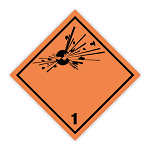
- Class 2: Gases
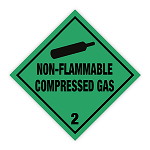
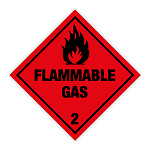
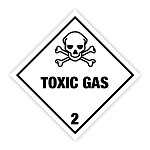
- Class 3: Flammable liquids
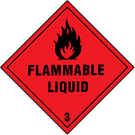
- Class 4.1: Flammable solids
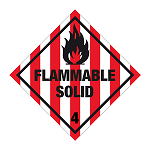
- Class 4.2: Spontaneously flammable substances
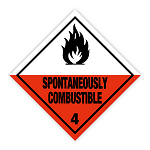
- Class 4.4: Substances developing flammable gas when in contact with water
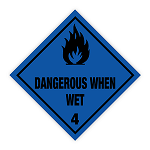
- Class 5.1: Oxidising substances
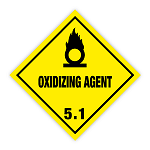
- Class 5.2: Organic peroxides
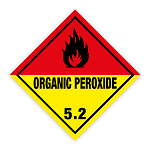
- Class 6.1: Toxic substances
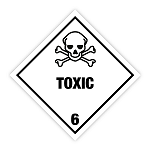
- Class 6.2: Infectious substances
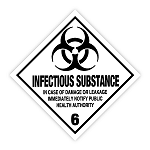
- Class 7: Radioactive material
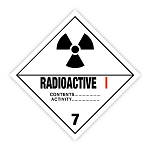
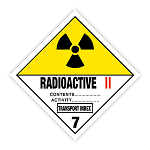
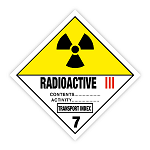
- Class 8: Corrosive substances
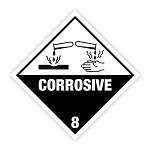
- Class 9: Various hazardous substances and objects. Note that lithium now has a separate hazard label, which should be used for disposal of lithium batteries.
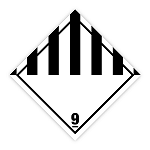
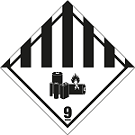
Information sheet
Hazardous biological materials and chemicals that do not have a safety data sheet, should have an information sheet. Information sheets contain information about hazardous properties, preventive safety measures and first aid treatment etc. For more information, see the Regulation of the performance of work, ch. 2 (in Norwegian). Information sheets are located in the NTNU substance index (in Norwegian) (ECO-Archive).
Safety data sheet
Safety data sheets contain information about hazardous properties, first aid measures, and handling and storage. Safety data sheets also contain information about UN number, danger classification and packaging category. The latter is specified in subsection 14, and is important with regard to the disposal of chemicals. For more information, see the Regulation of the performance of work, ch. 2 (in Norwegian). Information sheets are located in the NTNU substance index (in Norwegian) (ECO-Archive).
UN number (FN-nummer)
All hazardous substances or hazardous substance groups with equal properties are assigned a 4-digit UN number. The numbers are determined by a UN expert committee. You can find the numbers in the instructions from NFFA (in Norwegian) (see the section Waste product number). UN numbers are specified in the declaration of hazardous waste.
Help
- Emergency plans
- Laboratory and workshop handbook (in Norwegian)
- Laboratories and workshops (in Norwegian)
- Purchase agreement between NTNU and Norsk Gjenvinning (in Norwegian)
- Environmental checklist (in Norwegian) (pdf) – NTNU
- Waste (in Norwegian) – the Norwegian Environment Agency
NTNU regulations
Legislation
- ADR/RID Regulation of land-carriage of hazardous goods (in Norwegian)
- The Working Environment Act (in Norwegian)
- The Workplace Regulation (in Norwegian)
- The Waste Regulation (in Norwegian)
- The Fire and Explosion Protection Act (in Norwegian)
- The Pollution Act (in Norwegian)
- Environmental Information Act (in Norwegian)
- Regulation of registration, evaluation, authorization and restriction of chemicals (REACH) (in Norwegian)
- Regulation of the Pollution Act's application with regard to radioactive pollution and waste (in Norwegian)
- Regulation of infectious healthcare waste (in Norwegian)
- Regulation of organisation, management and partaking (in Norwegian)
- Regulation of measure and boundary values (in Norwegian)
- Regulation of the performance of work (in Norwegian)
Contact
- Questions about handling and disposal of hazardous and infectious waste, incl. sorting, packaging, marking and declaration of hazardous waste. All orders, including packaging and label orders etc., are made through the order system):
- Norsk Gjenvinning AS, contact person Patrick Fløistad; patrick.floistad@ngn.no, phone: 92600031 08:00–16:00, all business days).
- NTNU safety adviser:
- Questions about pick-up times:
- Norsk Gjenvinning AS, Driving office; ng.trondheim@ngn.no, tel. 98709700
- Questions about pricing, terms, invoices, nonconformities and quality:
Norsk Gjenvinning AS, contact person Jørn Viggo Lofstad; jorn.viggo.lofstad@ngn.no, phone: 97058874. Note that all waste quantities are rounded up to the nearest kg! - Espen Fjærvik, HSE Adviser, NV faculty (waste handling at NV and creating user accounts on avfallsdeklarering.no)
- Ingvild Hammer, HSE Adviser, MH faculty (waste handling at MH and creating user accounts on avfallsdeklarering.no)
- Ragnar Hellan, Operations Manager (waste handling at NTNU)
- Arve Johansen, HSE Adviser (hazardous waste, infectious waste and creating user accounts on avfallsdeklarering.no)
- Ann Kristin Sjaastad – Cert. Occupational Hygienist (radioactive waste)
Approval/signature
Approved by the Director of HSE – 12 August 2021 – HMSR18
Edited 07.04.2021
Child Pages (3)
-
Disposal of chemical waste
The content on this page has been moved to i.ntnu.no/en/hms/prosedyre-for-avhending-av-kjemikalier-og-gasser.
-
Disposal of infectious waste
These guidelines describe handling and disposal of infectious waste. Each unit is responsible for handling its own infectious waste. Individuals handling infectious waste are obligated to...
-
Radiation protection - radioactive waste
These guidelines apply to all units that produce radioactive waste after using open radioactive sources, and all units that permanently remove sealed radioactive sources from use. The purpose is to...
